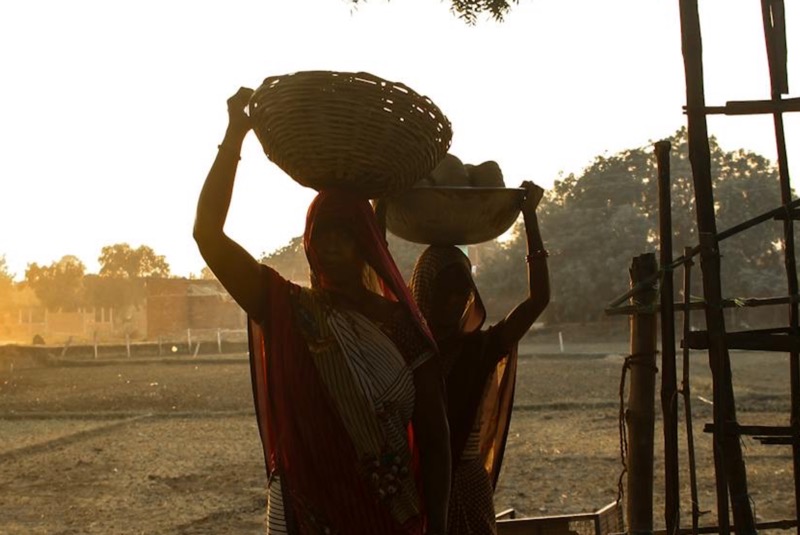When I ask Kuvalai to sit inside, she clasps her hands with a slight bow and politely refuses. For some reason, she seemed more comfortable outside the house, on the steps of the kitchen verandah. It took more persuasion to convince her to sit.
“Should I say my name?” she doubtfully asks.
“Yes, go ahead. I’ll change your name so you won’t have to be afraid. You can speak freely.”
“No, she’s not afraid”, my aunt interrupts.
Kuvalai has worked for my family for more than a decade now. She has helped build both of my aunt’s houses and multiple other houses in the neighbourhood. In addition, she does domestic chores in the houses she helped build to sustain her family.
“I usually get work when house owners or families call me. I leave at eight-thirty in the morning and work till five thirty in the evening”, she says. Koels hum in the background as Kuvalai speaks. “When I get to work, I begin by loading and unloading things and then do the rest of the handiwork. At one o’clock, we break for lunch, resume at two and work till five thirty”.
There is a lot of pain in Kuvalai’s eyes. Even though I’ve seen her for the better part of my life, I had never bothered to actually look at her. Her life echoes that of most female labourers in India—struggling to make ends meet while remaining invisible to mainstream society. Her synthetic saree is well draped, and her skin is dark and frail from the brunt of everyday labour. Her fine, greying hair is neatly tied in a bun.
I ask her who she works with and if there are other women. “There is one other woman. The rest of them are men,” she tells me. There are around five or seven of us. Most of them are North Indians. “
For the most part, Kuvalai is very hesitant to talk. Her lips break into a shy, scared smile when she speaks, changing to a subtle but painful frown when she stops. Her eyes wander around the kitchen garden, only fleetingly making eye contact with mine.
“If they pay 800 rupees, we end up getting only 700. In some houses, though, they directly give us 700”, she says. Kuvalai and almost every construction worker these days get work through a middleman – a contractor. Construction builders or employers pay workers through this contractor. In the process, the contractor takes a cut from each labourer’s wages, but the catch is that they take a larger cut from women than men. While an average female labourer’s wage is 700-800 rupees, a male worker’s wage is set at 900-1000 rupees. When I ask her why they pay men more, she says, “Well…That’s because they are men”.
While contractors take a hundred rupee cut from female workers, they only take a fifty-rupee cut from men. When I ask her why, she laughs and says, “You might have to ask Paul Ettan (her contractor) to know that”. Positively still, there are places where women receive a complete wage of 800 rupees, albeit only because they are paid even more, Kuvalai tells me. “We would never know our real wage as it comes through the contractor. We only get to know when we talk directly to our employers”, she says.
But there is more to the story. “Sometimes men take up the heavier blocks to elevations and us women the lighter blocks”. Thereby, it cannot be denied that, to an extent, there is a difference in labour between the two genders. “But we also do take up heavy blocks. If they can’t reach it sometimes, we are the ones who help”, she says with a nod. I asked her if it was right to pay women less. She smiles weakly before answering, “It is not. But we take what we can get”.
On the contrary, Kuvalai tells me there is no difference in how they treat men and women on site. “They don’t see us any differently, and it has been that way for almost two decades”. I ask her if she faces any problems at work, and she responds, “There’s no problem…no problem at all”. I am unsure whether there is no problem or she doesn’t want to raise any.
I try to explain how society sees men and women differently regarding paid and unpaid work. It takes a few attempts to get my concept across. In India, women like Kuvalai are unaware of domestic equality. When I ask what she thinks of it, she says, “That’s just the way I have lived. I have never felt any sadness when it comes to that, my dear. It’s just life”. The reality is that after work, the men usually freshen up, gather around and smoke a few cigarettes while the women go home to perform household chores. A lot of this unpaid work goes unrecognised and is deeply undervalued.
“I started going for construction work after I gave birth. All my four pregnancies were over by the time I was thirty”, Kuvalai says. Physically, she doesn’t look like she has four kids. She is lean and frail but still bursting with energy. When her kids were young, she would take them along while she dried hay and did other domestic chores for money. But because she couldn’t make ends meet with that pay, she ventured out to work in construction, where she would load mud and mix cement to build houses for the rich.
When I tell her how men have no such qualms about pregnancy and childcare, Kuvalai tells me very empathetically how such differences shouldn’t be considered. “Most of them come from faraway towns to work in this scorching heat. So we shouldn’t complain about what we get”, she says. Moreover, male labourers work on elevated platforms – like the first floor of a house under construction, while women mostly stick to groundwork and mixing. So, in scenarios where men perform more labour-intensive work, Kuvalai thinks they rightly deserve more pay. “Even the contractors need money, so I understand why they take cuts, and that’s how it is in every company”.
Although such reasons stand entirely valid, they do not justify the difference in cuts between men and women. When I remind her of this, she says, “We do tell them that this wage isn’t enough for all the difficulty we go through, and sometimes they might add an extra fifty rupees for tea, but that’s about it”. When Kuvalai started out, there was virtually no pay for women. “We would be paid just eighty rupees for loading heavy, machine-cut stones”. But even then men would be paid higher – for every 80 rupees a woman labourer received, a male labourer would get 150. “We had to work so much just to earn 80 rupees. It’s not easy lifting machine-cut stones over a two-storied building”, she says.
As men dominate the field, she tells me that the few women who work in construction are present to help men. “Construction is a difficult field, and the men work immensely hard. So when it gets a little hectic, we are there as a helping hand”. The male labourers who work with Kuvalai know the wage difference and sometimes even ask why it exists. But other than a few questions here and there, nothing has come to fruition.
While wages have increased over time, the wage difference for equal work done between men and women has remained constant. The saddest aspect of all this is that there is no glimmer of hope for women like her. “I don’t think women and men will ever be paid the same,” she dismissively says. We can only take what we get, and this is just how life is,” she reiterates.
While discussing the gender pay disparity, almost always the first arguments that arise are based on the idea that people are paid for the work they do and the value they bring to the table, and so naturally, if women are being paid less, it would only imply that they do not perform as well as their male counterparts. This idea not only blatantly disregards the larger matter at hand, which is that the pay disparity extends to much more than getting equal pay for equal work, but also instigates a highly toxic and ancient thought process of deeming women as inferior and less capable than men.
Such a response to a very broad issue represents the structures of a patriarchal society which places men on higher pedestals and continues to overlook women’s roles and identities. This can again be traced back to the idea of a male-dominated society, proving how interconnected all these factors are, forming an endless loop and leaving no space for reform or change.
The world finds it easier to forget women like Kuvalai. Perhaps it is easier to leave them behind in the dust and dirt they toil in?
Today, Kuvalai mostly does domestic work in houses since there are not many construction opportunities in the area where she lives. There is no fixed number of houses she attends to as it changes daily. “I just go whenever people call”, she says. Her average wage is around 650-700 rupees per day. “I’ve gone to a hundred places for work. I just don’t work in construction now as it’s hard and even dangerous sometimes. So I thought I’d stop all that and work smaller jobs”.
She asked me if I had my evening tea and whether I understood everything.
“Yes, I understood”.
“Good. You should know all this, my dear”, Kuvalai says with a smile before waving goodbye and disappearing into the darkness.
-30-
Copyright©Madras Courier, All Rights Reserved. You may share using our article tools. Please don't cut articles from madrascourier.com and redistribute by email, post to the web, mobile phone or social media.Please send in your feed back and comments to [email protected]











